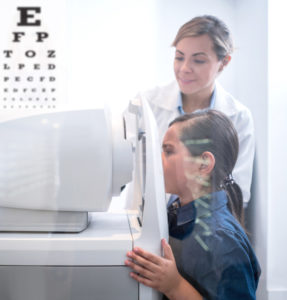May 1, 2023
By Thomas Naduvilath, Msc Biostatistics, PhD, Head of Biostatistics at BHVI
It has been recommended that axial length be considered the primary outcome for determining progression and that practitioners adopt axial length measurements in managing myopia.
 Refractive error measurements are the common approach to monitoring myopia progression. However, with more advanced techniques to measure biometry parameters, there is increased motivation toward using axial length, which is the distance from the anterior cornea to the retina along the line of sight.
Refractive error measurements are the common approach to monitoring myopia progression. However, with more advanced techniques to measure biometry parameters, there is increased motivation toward using axial length, which is the distance from the anterior cornea to the retina along the line of sight.
Accuracy and Reliability
The increased interest in axial length measurements compared to refractive error is driven by the improvement in accuracy and reliability in a rapid and non-invasive manner using interferometric axial length technology and optical coherence tomography.1 This provides several advantages when examining young children, especially in environments where a cycloplegic assessment is not feasible. Myopia management using orthokeratology is assessed exclusively using axial length measurements, as the treatment induces changes in the refractive components independent of axial length.2 Additionally, changes in axial length correlate strongly with refractive error changes, though the absolute values show a weaker correlation.3 Thus, it has been recommended that axial length be considered the primary outcome for determining progression and that practitioners adopt axial length measurements in managing myopia.4,5 Moreover, FDA lists both axial length change and refractive error change as primary effectiveness endpoints for clinical trials that assess myopia control devices but favors the use of axial length.
Percentile Curves to Monitor Progression
To aid clinicians in the use of axial length, population-specific percentile charts have been developed as a tool to monitor the risk and progression of myopia.6,7 These charts are helpful to identify those patients experiencing higher than expected axial elongation, which is a function of age, gender, and ethnicity, and accordingly commence or alter myopia management strategies.8 On a typical axial length percentile chart, a curve represents a percentile across age from the reference population.
Plotting a child’s axial length on an age-specific curve provides a rank relative to the reference population that indicates the percent of the population the child’s axial length would equal or exceed. Plotting follow-up measurements of axial length on percentile charts can be used to monitor axial length growth or the efficacy of myopia treatments by assessing the child’s percentile changes over time.
Despite technological advancements in the measurement of axial length, using an optical biometer as a gold standard remains a challenge, particularly with the high cost differential between instruments. Moreover, refractive error under cycloplegia continues to be the definitive indicator of myopia classified as -0.50D or worse. Still, no such classification of axial length is agreed upon, though 23.85 mm has been suggested to be the cutoff for myopia onset.4 While high myopia is categorized using refractive error, multiple thresholds using axial length have been suggested, such as 25.5, 26.0, and 26.5 mm. To summarize, refractive error measurements are preferred for categorizing and identifying myopia onset, but axial length measurements are preferred for monitoring progression once myopic.
Jobson's OrthoK Research Report
Efficacy of Different Treatments
Certain myopia control treatments, such as OrthoK, use axial length measurements as the only means of assessing efficacy. However, pharmaceutical treatments such as atropine drops and pirenzepine ointment for myopia control tend to demonstrate efficacy using refractive error only. Studies on low-dose atropine did not significantly reduce axial length progression despite showing a significant reduction in refractive error progression.9 With the increasing popularity of these pharmaceutical treatments for myopia control in children, replacing axial length in favor of refractive error is likely to be resisted by researchers and clinicians. Axial length needs to be retained as the preferred measure of efficacy if the ultimate objective of myopia control is to reduce the risk of long-term myopia-related diseases rather than short-term gains in refraction.
Myopia researchers and the FDA are promoting axial length as the preferred metric to assess myopia progression, which has a clear advantage over refraction measurements in terms of precision, reliability, and ease of use. Axial length measurements coupled with percentile charts further improve patient awareness and engagement in myopia management.
 |
Thomas Naduvilath, Msc Biostatistics, PhD, is the Head of Biostatistics at BHVI and a Conjoint Associate Professor at the School of Optometry and Vision Science, University of New South Wales. |
To read more from Dr. Naduvilath on axial length measurements, click here.
References
- Song JS, Yoon DY, Hyon JY JH. Comparison of Ocular Biometry and Refractive Outcomes Using IOL Master 500, IOL Master 700, and Lenstar LS900. Korean J Ophthalmol. 2020;34(2):126–32.
- Cheung SW, Cho P. Validity of Axial Length Measurements for Monitoring Myopic Progression in Orthokeratology. Invest Ophthalmol Vis Sci. 2013;54(3):1613–5.
- Olsen T, Arnarsson A, Sasaki H, Sasaki K, Jonasson F. On the ocular refractive components: the Reykjavik Eye Study. Acta Ophthalmol Scand. 2007 Jun;85(4):361–6.
- Brennan NA, Toubouti YM, Cheng X, Bullimore MA. Efficacy in myopia control. Prog Retin Eye Res. 2021 Jul;83:100923.
- Wolffsohn JS, Kollbaum PS, Berntsen DA, Atchison DA, Benavente A, Bradley A, et al. IMI – Clinical Myopia Control Trials and Instrumentation Report. Invest Ophthalmol Vis Sci. 2019 Feb;60(3): M132–60.
- Tideman JWL, Polling JR, Vingerling JR, Jaddoe VW V., Williams C, Guggenheim JA, et al. Axial length growth and the risk of developing myopia in European children. Acta Ophthalmol. 2018 May;96(3):301–9.
- He X, Sankaridurg P, Naduvilath T, Wang J, Xiong S, Weng R, Du L, Chen J, Zou H XX. Normative data and percentile curves for axial length and axial length/corneal curvature in Chinese children and adolescents aged 4-18 years. Br J Ophthalmol. 2023;107(2):167–75.
- Klaver C, Polling JR. Myopia management in the Netherlands. Ophthalmic Physiol Opt J Br Coll Ophthalmic Opt. 2020 Mar;40(2):230–40.
- Yam JC, Jiang Y, Tang SM, Law AKP, Chan JJ, Wong E, et al. Low-Concentration Atropine for Myopia Progression (LAMP) Study: A Randomized, Double-Blinded, Placebo-Controlled Trial of 0.05%, 0.025%, and 0.01% Atropine Eye Drops in Myopia Control. Ophthalmology. 2019;126(1):113–24.













